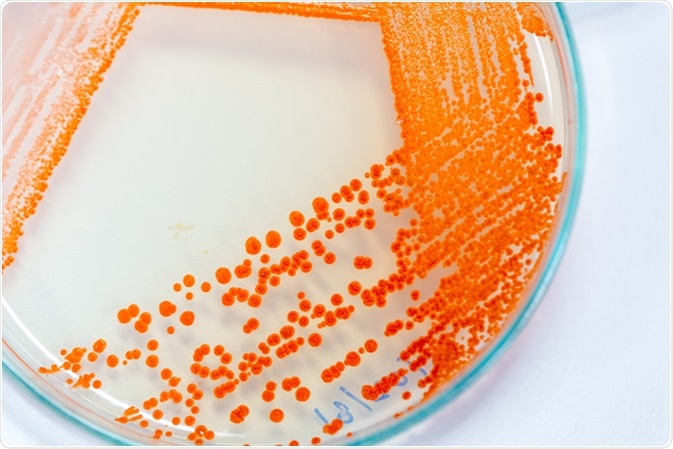Differentiating bacterial strains within a single sample can be a daunting challenge. Microscopic studies of the sample can be used for simple identification and differentiation tasks.
Microbiologists can identify the microbe by its morphological features and document all of the organisms in the sample.
Staining, culturing, and simple biochemical tests are other traditional methods for distinguishing between microbial species.

Serratia marcescens is a species of rod-shaped gram-negative bacteria in the family Enterobacteriaceae for Laboratory microbiology. Image Credit: Rattiya Thongdumhyu / Shutterstock
Traditional Methods
Microscopic features that can be used to identify bacteria include the overall shape of the microbe. Microbes can be shaped like rods, spheres, or spirals, or other shapes.
Gram staining is a very common test used to determine the type of bacteria in a culture. It was named after the Danish bacteriologist Hans Christian Gram.
Species including Bacillus, Staphylococcus, Streptococcus, and Clostridium turn purple with Gram stain.
Other species like Escherichia, Helicobacter, and Salmonella are gram-negative, meaning they don’t change color with Gram stain.
Some examples of biochemical testing include catalase testing, oxidase testing, and substrate utilization tests.
Modern Methods
However, for some applications the numbers of bacteria are too great, or there are a great many unknown species and other methods are necessary to differentiate them.
Some newer, more sophisticated methods for differentiating between microbes include PCR-based identification, microarray-based identification, and immunological identification.
How to Screen Bacterial Colonies with PCR
In PCR-based identification, real-time PCR is used to amplify certain genes which are then sequenced to confirm the identity of the microbe.
In microarray-based identification, microbial DNA sequences are hybridized to species-specific oligonucleotide probes in a grid format.
The identity of the microbe can then be determined by finding the “address” on the grid of a positive result.
An immunological assay can detect species of microbes by linking antibodies for species-specific proteins to a detection method such as a dye.
Methods like fatty acid profiling and chemo-profiling can also distinguish different microbes from each other.
Microbial species often have unique combinations of fatty acids or metabolites that can distinguish them from each other.
Metagenomics
In metagenomics studies, researchers have had success using genome sequencing to identify microbes in a sample.
For example, in a study of Crohn’s disease, researchers are using sequencing to explore whether certain species of bacteria influence the function of the gastrointestinal microbiota in patients with Crohn’s disease compared with healthy individuals, and which microbial signatures correlate with occurrence and progression of the disease.
In some cases, species-level differentiation might not be enough, and scientists may need to identify individual strains.
In one case, U.S. officials found that Shiga-toxin-producing Escherichia coli was the source of a food poisoning outbreak in Germany in 2005 and 2006.
The researchers used PCR and nucleotide sequencing to identify the subtypes of specific variant genes between the strains to identify the strain responsible for the outbreak.
Metagenomics-Biology Beyond the Microscope (Mississippi Metagenomics at UMN)
Mass Spectroscopy
Instrumental methods can also be used to differentiate bacteria. For example, researchers used laser desorption postionization mass spectroscopy to differentiate microbial species and strains in a co-culture biofilm.
They used cocultures of E. coli and Saccharomyces cerevisiae to mimic a naturally occurring producer-consumer ecological biofilm system.
Other mass spectroscopy methods that have been used to differentiate species of bacteria are secondary ion mass spectra (SIMS) and matrix assisted laser desorption ionization mass spectroscopy (MALDI-MS).
Reviewed by Megan Knight, BSc
References
- Microbiology: the road to strain-level identification, https://www.nature.com/articles/nmeth.3837
- Metagenomic analysis of the structure and function of the human gut microbiota in Crohn’s disease, https://www.ncbi.nlm.nih.gov/projects/gap/cgi-bin/study.cgi?study_id=phs000257.v2.p1
- Identification of human-pathogenic strains of Shiga toxin-producing Escherichia coli from food by a combination of serotyping and molecular typing of Shiga toxin genes, http://aem.asm.org/content/73/15/4769.full
- Differentiation of microbial species and strains in coculture biofilms by multivariate analysis of laser desorption postionization mass spectra, https://www.ncbi.nlm.nih.gov/pmc/articles/PMC3833099/
- Crash course in microbial identification, https://bitesizebio.com/36644/methods-microbial-identification/
Further Reading
Last Updated: Aug 23, 2018